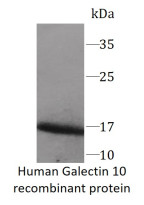ARG70464
Human Galectin 10 recombinant protein (His-tagged, N-ter)
Human Galectin 10 recombinant protein (His-tagged, N-ter) for SDS-PAGE
Overview
| Product Description | E. coli expressed, His-tagged (N-ter) Human Galectin 10 recombinant protein |
|---|---|
| Tested Application | SDS-PAGE |
| Target Name | Galectin 10 |
| Species | Human |
| A.A. Sequence | Ser2 - Arg142 |
| Expression System | E. coli |
| Protein Full Name | Galectin-10 |
| Alternate Names | CLC; Charcot-Leyden Crystal Galectin; LGALS10 Gal-10; Charcot-Leyden Crystal Protein; Eosinophil Lysophospholipase; Lysolecithin Acylhydrolase; Lectin, Galactoside-Binding, Soluble, 10; Galectin-10 |
Properties
| Form | Powder |
|---|---|
| Purification Note | Endotoxin level is less than 0.1 EU/µg of the protein, as determined by the LAL test. |
| Purity | > 98% (by SDS-PAGE) |
| Buffer | PBS (pH 7.4) |
| Reconstitution | It is recommended to reconstitute the lyophilized protein in sterile water to a concentration not less than 200 μg/mL and incubate the stock solution for at least 20 min at room temperature to make sure the protein is dissolved completely. |
| Storage Instruction | For long term, lyophilized protein should be stored at -20°C or -80°C. After reconstitution, aliquot and store at -20°C or -80°C for up to one month. Storage in frost free freezers is not recommended. Avoid repeated freeze/thaw cycles. Suggest spin the vial prior to opening. |
| Note | For laboratory research only, not for drug, diagnostic or other use. |
Bioinformation
| Gene Symbol | CLC |
|---|---|
| Gene Full Name | Charcot-Leyden Crystal Galectin |
| Background | Lysophospholipases are enzymes that act on biological membranes to regulate the multifunctional lysophospholipids. The protein encoded by this gene is a lysophospholipase expressed in eosinophils and basophils. It hydrolyzes lysophosphatidylcholine to glycerophosphocholine and a free fatty acid. This protein may possess carbohydrate or IgE-binding activities. It is both structurally and functionally related to the galectin family of beta-galactoside binding proteins. It may be associated with inflammation and some myeloid leukemias. |
| Function | Regulates immune responses through the recognition of cell-surface glycans. Essential for the anergy and suppressive function of CD25-positive regulatory T-cells (Treg). |
| Cellular Localization | Cytoplasm |
| PTM | Acetylation |
Images (1) Click the Picture to Zoom In






